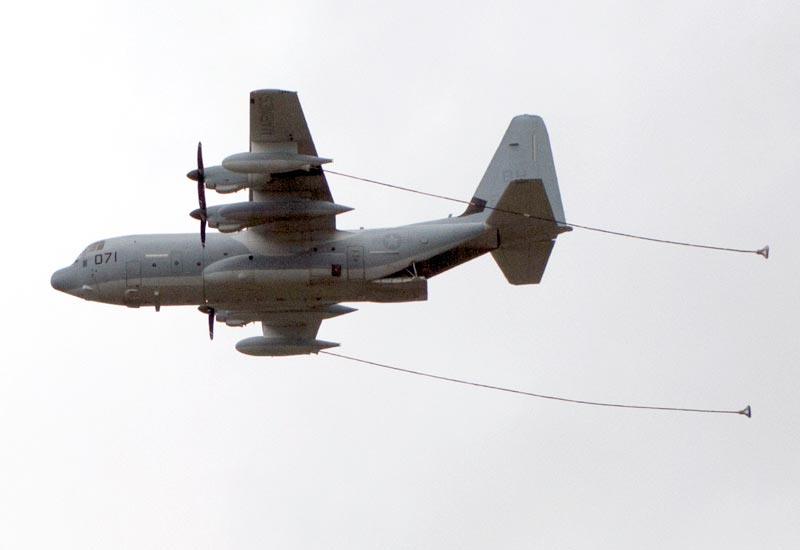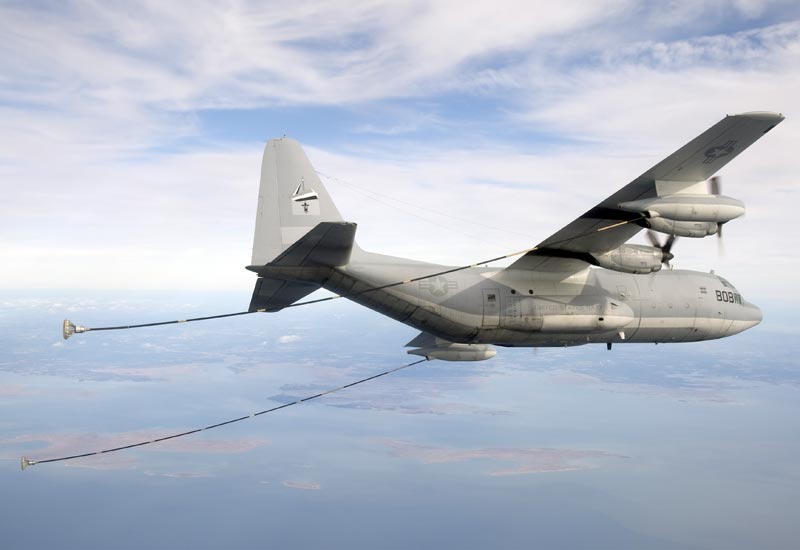Aerial refueling & transport aircraft, renowned for versatility and reliability in military operations worldwide.
In Brief
The Lockheed Martin KC-130 Hercules is a multi-role, medium-sized military transport aircraft that excels in aerial refueling, logistics, and troop transport. Based on the C-130 Hercules airframe, it incorporates advanced avionics, refueling systems, and cargo handling capabilities, making it a backbone for tactical airlift and air-to-air refueling missions. Powered by four Allison T56-A-16 turboprop engines, it achieves a balance of efficiency, range, and payload capacity, capable of operating in diverse environments, from conventional runways to austere airfields in combat zones.
The Lockheed Martin KC-130 Hercules stands as a testament to the enduring design and versatility of the C-130 airframe, adapted over the years to meet evolving military requirements for air mobility, logistics support, and aerial refueling.

History of the Development of the Lockheed Martin KC-130 Hercules
The KC-130’s development can be traced back to the early 1960s, amidst Cold War demands for enhanced military logistics and air mobility. Lockheed, having introduced the C-130 Hercules in 1954, recognized the potential for a variant specialized in aerial refueling. The U.S. Marine Corps, seeking a robust platform for rapid deployment and sustainment of forces, became the primary operator of the KC-130 variant.
The KC-130 first flew in the early 1960s, responding to the need for a versatile aircraft capable of performing both airlift and refueling missions. Its design capitalized on the Hercules’ proven reliability, ruggedness, and flexibility, incorporating aerial refueling systems without compromising its cargo handling capabilities.
Design of the Lockheed Martin KC-130 Hercules
The KC-130 Hercules incorporates a high-wing design, allowing for a spacious cargo area and unobstructed access via the rear-loading ramp. The aircraft is powered by four Allison T56-A-16 engines, each driving a four-blade propeller, providing the lift and thrust necessary for heavy loads and long-range missions.
One of the key advantages of the KC-130 is its dual-role capability, equipped with both a drogue-and-hose and a flying boom refueling system, enabling it to refuel a wide variety of receiver aircraft. However, this versatility comes with the challenge of balancing weight, fuel capacity, and cargo space, requiring careful mission planning to optimize its effectiveness.
Performance of the Lockheed Martin KC-130 Hercules
The KC-130 Hercules showcases impressive performance metrics, with a maximum speed of approximately 336 mph (540 km/h) and a range of over 2,500 miles (4,000 kilometers) when fully loaded. It can operate from austere runways, making it indispensable for forward-deployed operations. When compared to other aerial refueling platforms, such as the Boeing KC-135 Stratotanker, the KC-130 offers greater flexibility in landing on shorter, unprepared runways, albeit with a smaller fuel offload capacity.
Variants of the Lockheed Martin KC-130 Hercules
The KC-130 series includes several variants, each tailored to specific operational requirements. The KC-130F was the initial model introduced, followed by improvements in the KC-130R and KC-130T, featuring enhanced avionics and refueling capabilities. The latest variant, the KC-130J, incorporates new engines, propellers, and a modernized cockpit, significantly improving performance and efficiency.

Military Use and Combat of the Lockheed Martin KC-130 Hercules
The KC-130 has been a critical asset in numerous military operations, from the Vietnam War to recent conflicts in the Middle East. It has supported airborne refueling, tactical airlift, and humanitarian missions, demonstrating unparalleled versatility. The aircraft has seen action in delivering troops and supplies, evacuating casualties, and providing aerial refueling to extend the reach of combat aircraft. Its armament capabilities, including the ability to deploy precision-guided munitions in some variants, have expanded its role to include direct support on the battlefield.
Throughout its service, the KC-130 has competed with and complemented other aerial refueling assets. Its ability to operate in environments inaccessible to larger tankers has made it invaluable. The KC-130 has been exported to several countries, enhancing global air mobility and refueling capabilities.
The Lockheed Martin KC-130 Hercules exemplifies the evolution of military aviation technology, adapting over decades to meet the changing needs of global air forces. Its design, balancing robustness with versatility, has made it an indispensable asset in military logistics, aerial refueling, and tactical airlift. As military operations continue to demand high levels of flexibility and reliability, the KC-130’s legacy of adaptability and endurance ensures it remains a vital component of air mobility and support strategies worldwide.
Back to Transport planes.